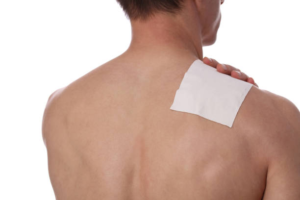Symptoms of Back Pain
Back pain is a common complaint that affects people of all ages. It can range from mild to severe and can be caused by a variety of factors such as muscle strain, poor posture, or injury.
Back pain often occurs in the lower back region but can also occur in the upper back, neck, and other areas. One of the common treatment is using patches for back pain. Back pain relief patches are a type of topical medication that provides targeted relief to areas of the back affected by pain. While mild cases of back pain usually resolve on their own with time and rest, more severe cases may require medical treatment to prevent further damage or disability.
Common Symptoms of Back Pain
The most common symptoms associated with back pain include:
- Aching or stiffness in the lower or upper back
- Difficulty moving without discomfort
- Sharp pains that travel down one leg or up into the neck
- Numbness or tingling sensations throughout the spine
- Muscle spasms in the area of discomfort
Less Common Symptoms of Back Pain
In some cases, more serious symptoms may accompany back pain including:
- Difficulty controlling bladder and bowel function (urinary incontinence)
- Severe weakness in one leg
- Loss of sensation throughout parts of your body
- Unusual sensations like burning or tingling down your legs
- Unexplained weight loss

Causes of Back Pain
Back pain is a common problem that affects millions of people around the world. It can range from mild to severe, but most cases can be managed with treatment and lifestyle modifications. While there is no single cause of back pain, there are certain factors that can increase your risk of developing it.
The most common cause of back pain is muscle or ligament strain, which occurs when the muscles and ligaments supporting your spine become injured due to overuse or sudden exertion. Muscle strain can be caused by prolonged sitting in an uncomfortable position, lifting heavy objects improperly, repetitive motions such as typing on a keyboard or using a jackhammer, or engaging in sports without proper warm-up exercises. Other causes of muscle strain include poor posture when sitting or standing for long periods of time and obesity since excess body weight puts additional pressure on the spine.
Another potential factor contributing to back pain is spinal disk injury. The disks between vertebrae act as shock absorbers for your spine and reduce stress on the bones and ligaments during movement; however, they are also susceptible to wear and tear over time as well as trauma such as car accidents or falls from heights which may lead to herniated discs in which part of the disk’s gel-like center pushes out.
Diagnosis and Treatment Options
Diagnosis and Treatment Options for Various Health Conditions
A diagnosis is a medical professional’s identification of a health condition in an individual. Diagnosis usually involves a physical exam, laboratory tests, imaging tests (such as X-rays), and/or other diagnostic procedures. After the diagnosis has been made, treatment options can be discussed between the doctor and the patient to determine the best course of action. Treatment options vary depending on the type of condition being treated.
Common conditions that are diagnosed include infections such as colds and flu; metabolic disorders like diabetes; chronic diseases like high blood pressure or heart disease; neurological disorders such as Alzheimer’s disease or Parkinson’s disease; mental health issues such as depression or anxiety; cancers; autoimmune diseases like lupus or rheumatoid arthritis; musculoskeletal injuries such as fractures or sprains; and much more.
Treatment options also vary depending on the condition being treated but may include medication, surgery, lifestyle changes (such as diet modification or exercise), physical therapy/occupational therapy, counseling/therapy sessions with a psychologist/psychiatrist, support groups, complementary therapies (such as acupuncture or massage), etc.
Overview of Patches for Back Pain
Back pain is a common issue that can range from minor to chronic and debilitating. Fortunately, there are several patches available to help alleviate symptoms and improve the quality of life for those suffering from back pain.
- Heat Patches: Heat patches work by delivering heat directly to the area of the body that is in pain. This helps reduce muscle tension and spasms, allowing for better blood circulation and easing discomfort. Heat patches are available in both reusable and disposable forms, with varying levels of heat intensity depending on the severity of the pain.
- Cold Compression Patches: Cold compression patches provide a cooling sensation directly to the affected area of the back, which can help reduce swelling while providing relief from acute pain. These patches usually contain menthol or camphor as active ingredients which creates a cooling tingling sensation when applied to the skin. Cold compression patches are also available in reusable or disposable forms for added convenience.
- CBD Patches: Cannabidiol (CBD) is an active compound found in hemp plants that have been studied extensively for its potential therapeutic benefits including relieving inflammation and reducing chronic pain related to conditions such as arthritis, fibromyalgia, neuropathy, etc.
Benefits and Risks of Using Patches for Back Pain
Back pain is a common problem that affects millions of people worldwide. Fortunately, there are numerous treatments available to help alleviate the discomfort associated with back pain. One such treatment is the use of patches, which can be applied directly to the skin to provide targeted relief from pain and inflammation.
Patches for back pain provide a number of benefits, including:
- Relief from acute or chronic back pain
- Targeted delivery of active ingredients directly to the site of injury
- Easy application and removal
- Non-invasive treatment option
- Low risk of side effects when used properly.
Despite these advantages, there are also risks associated with using patches for back pain. For example:
- The patch may not stick properly if applied incorrectly or on oily skin. This can lead to ineffective results or even worse – an allergic reaction due to potential exposure to allergens in the patch adhesive material.
- Patches may cause skin irritation or rashes in some people, especially those with sensitive skin types. It is important to read all instructions carefully before applying any type of topical medication and discuss any potential side effects with your doctor before use.

Alternatives to Patches for Treating Back Pain
Back pain can be a debilitating and painful experience that affects people of all ages and from all walks of life. If you suffer from chronic back pain, you may have already tried medication, physical therapy, or even surgery to treat your condition but still find yourself in constant discomfort. Patches are one option for managing back pain over time, but there are other alternatives that may be more effective for reducing your symptoms.
Acupuncture is an ancient Chinese practice that involves inserting very thin needles into specific points on the body to reduce inflammation and improve circulation. Studies have suggested that acupuncture helps to reduce lower back pain in some patients by releasing endorphins which help manage the discomfort associated with chronic back pain.
Yoga is another great way to address lower back issues without needing any medications or patches. It’s low-impact enough so as not to aggravate existing conditions while strengthening muscles around the spine and providing relief through stretching exercises specifically designed for this purpose. Additionally, yoga can help combat stress related to chronic pain which can also contribute to an overall decrease in discomfort levels due to its calming effect on the mind and body alike.
Conclusion
In conclusion, patches for back pain can be a great solution for those suffering from chronic pain due to its convenient and discreet application. While some people may experience relief from using topical patches, it is important to talk with your doctor before starting any new treatment. Patches are not meant to replace other treatments but can be used in conjunction with them, depending on the individual’s needs.

